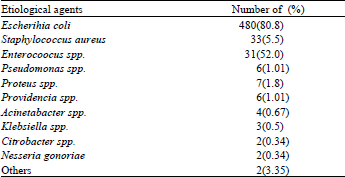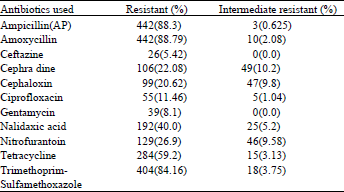Research Article
Prevalence and Antibiotic Susceptibility of E. coli Isolated from Urinary Tract Infection (UTI) in Bangladesh
Compath Limited, Elephant road, Dhaka, Bangladesh
H. Rashid
ARI Lab, Icddr B, Bangladesh
Urinary tract infection (UTI) is one of the most common types of nosocomial bacterial infection and because of its high incidence; it is responsible for an enormous aggregate burden of morbidity, mortality and increased health care costs[1-5]. Member of the Enterobacteriaceae especially E. coli are the cause of the majority of UTI[6]. UTIs result in approximately eight million physician visit and more than 1,00000 hospital admissions per year in the US[7]. The most frequent organisms causing UTI are E. coli, less common are Klebsiella spp., Enterobacter spp., Proteus spp., Streptococcus group B and Enterococci spp., where as Haemophilus influenzae, Salmonella spp., Shigella spp., Anaerobes, Yeasts or Mycobacteria are rare.
Uncomplicated UTI occur those who have a history of lower UTI symptoms of short duration. The microbiology of uncomplicated UTI is predictable with E. coli[8,9] and other Enterobacteriaceae[10].
For the therapeutic reasons it is useful to distinguish between uncomplicated and complicated infections are due to the most common microorganisms eg. E. coli, Klebsiella spp., P.miribilis, S. saprophyticus in the absence of functional or anatomical abnormalities. They are often linked to positive personal family history with UTI, the use of diaphragm or spermicidal. This type of infection can be treated with a short course of antibiotics.
In contrast complicated UTI, more frequently due to S. aureus or P. aureginosa are linked to functional or anatomical dysfunctions to instrumentation, catheterization or recent use of antibiotics. Risk factors for complicated UTI include males, elderly persons, previous or actual hospitalization, pregnancy duration of symptoms>seven days, presence of stones, in dwelling catheters, recent instrumentation, anatomical abnormalities, history of UTI in childhood, immune suppression or recent use of antibiotics. These types of infection need a prolonged antibiotic treatment to be cured.
Anti microbial agents are among the most frequently prescribed drugs in nursing home is most commonly for UTI[11]. The high consumption of often inappropriately prescribed antibiotics combined with crowding, multiple pathology and frequent use of invasive devices, in a major factor contributing to high level resistance. Random and extensive use of brood spectrum of antibiotics contributed to changes in the microbiological and antibiotic susceptibility patterns of pathogens isolated from UTI. To provide appropriate treatment, physicians need to no know local patterns of microbial susceptibility and cost effectiveness for proper drug selection[12].
The purpose of the current study is to identify to choice proper therapy of the prevalence microorganisms.
Their anti-microbial susceptibility patterns and risk of different age and sex in UTI.
This is a retrospective study, which was carried out among the patients who came which UT symptom to a community diagnostic center in Dhaka city during January 2001 to December 2001.
Patients selection: The patients who had a history of UT symptom were included in this study. A total of 1962 subjects were enrolled in this study and midstream morning urine specimens were collected aseptically for culture.
Culture: 100 μl of specimen was inoculated on MacConkey agar and Nutrient agar plate with the half an hours. The plates were incubated at 37°C for 24 to 48 hr. After 24 to 48 hr the plates were examined for bacterial pathogens. The growth was significant at 105 ml–1. Significant bacterial isolates were subjected to antibiotic susceptibility testing.
Antibiotic Susceptibility: The sensitivity was tested by Kirby-baur disc diffusion technique. The result was interpreted as susceptible (S), intermediately resistant (IR) and resistant(R). The antibiotics disc (Oxoid, UK) used is[1]: Penicillin[2], Ampicillin[3], Gentamycin[4], Celfejidine[5], Tetracycline[6], Amoxicillin[7], Cotrimoxazole[8], Nitrofyrantoxin[9], Nalidaxic Acid[10], Ceftriaaxone[11], Cephadine[12], Ciproflox[13], Ceftazidine.
A total of 1951 patients were enrolled in this study. The male female ratio was 1.12:1. Of the total patients 30% was positive by urine culture test. Among the positive cases female was 348 out of 921 and male was 246 out of 1030. Female cases were more positive than male. The pathogens isolation rate was greater in female 348/594 than in male 246/594 (Table1).
Patients included in this study were included in all age group. Most of the patients were below 40 years. The age group and respective positive cases are summarized in the (Table 2). Positivity of female cases is greater than the male cases in all age groups. The rate of positivity is frequent in the age groups<10 and >60 yrs. The isolation rate in female is greater in all age group except <10 yrs where isolation rate in male is higher.
Among the positive cases E. coli (81%) and others major bacteria isolated were Staphylococcus aurous (5.5%) Enterococcus spp. (5%), Pseudomonas spp. (1%), Ptoteus spp. (1%). Providencia spp. (.85%), Acenetobacter spp. (.65%), Klebsiella spp. (.5%), Citrobacter spp. (0.35%), Neisseria gonoriae (.35%) and others pathogens are 3.7% (Table 3).
E. coli resistant to Ampicillin/Amoxicillin (88%), Cetrimoxazole (84%), Tetracycline (59%), Cefriaxone (5.5%)Ceftazidine (5.5%), Cephradine (22%) Cephalexin (20.6%), Ciprofloxacin (11.5%) Gentamycin (8.1%) Nalidixic acid (40%) and Nitrofurantoxin 26.9%. Same occurrence was found in antibiotic resistance patterns for others bacteria (Table 4).
Antibiotic susceptibility results of all bacterial isolates were presented in the (Table 5). With combination all pathogens of both Gram-positive and Gram-negative groups were highly resistant (70-90%) to Ap, Amox, Sxt and Tet as well as highly susceptible (88-95%) to Gm, Cro, Cfz and Cip; the rest of antibiotics such as Nft, Cef, Cpl and Na shows moderate rate of antibiotic susceptibility (55-70%).
UTI is caused by bacteria in urine, which have the potentiality to change tissues of the urinary tract adjacent structures. The prevalence of UTI varies according to sex and age[13]. The female is more prone to UTI for anatomic reasons; short and straight urethra and short distance between the ostium of the urethra and the anus contribute to the easy colonization of the peri-urethral region with enteric bacteria, equipped with appropriate pilli, fimbrae etc. attaching to the mucosal surface. In the present study infection rate is also higher in female than male cases.
In our study higher rate of UTI in case of <10 yrs ages and >60yrs ages.UTI in >60 yrs is very usual but UTI in <10 yrs ages can be explained as having structural abnormalities, obstruction of the Urinary tract that placed them at higher risk for UTI.
In the study both Gram-positive and Gram-negative pathogens were isolated. Predominantly E. coli 81% followed by S. aureus, Enterococcus spp., Providencia spp., Proteus spp., Citrobacter spp., Acinetobacter spp., Klebsiella spp. etc.
In most of the studies E. coli was the prevalent organism also[8,9,14]. In our study isolation rate of Klebsiella spp. and Pseudomonas spp. were less compare to others studies[15]. Klebsiella spp. and Pseudomonas spp. were the predominant organisms in nosocomial UTI[16], significantly associated with age, diabetes mellitus and uregenital instrumentation.
| Table 1: | Seasonality and sex distribution of urinary tract infection cases (N=1951) |
 | |
| Table 2: | Age and sex distribution of UTI cases |
 | |
| Table 3: | Urine culture result (positivity and percentage) of UTI |
 | |
| Table 4: | Antibiotic resistant patterns of E. coli [N=480] |
 | |
In our study E. coli and other Gram-negative organisms are highly resistant to most of the conventional drugs for urinary isolation. eg. Ampicillin, Amoxicillin, Tetracycline, Co-trimexazole and moderate resistant to Nalidixic acid, Nitrofurantoxin, Cefradine, Ciprofloxacin and sensitive to Getamycin, Cephalexin, Cefriaxone and Ceflazidime. Staphylococcus aureus was highly resistant to Ampicillin, Amoxicillin, Tetracycline and Cotrimoxazole and sensitive to Gm, Cip, Cro, Caz, Nft, Cpl and Cef.
In our study, E. coli sensitive to Ap (11%), Amox (10%) Sxt (16%), Cef (95%), Cpl (80%), Nft (64%), Tcl (38%), Na (55%), Cip (88%), Gm (92%), Cfz (94%) were almost similar to another Bangladeshi studies[15].
In a study conducted in Jordan where 82% isolates were E. coli was most similar to our study. Antibiotic resistance rate of E. coli in the same study was Ap 95%, Tcl, Carbenicillin 84%, Trimethoprim/Sulfamethoxazole 48% were comparable to our study[17]. Another study conducted in Karachi, Pakistan where 45.6% isolates were E. coli were very lower than our study. Antibiotics resistance rates for E. coli were Ap 76%, Cfz 80%, Nft 20.5%, Gm 35%, were different to some extent from our study [17]. Most all the resistant E. coli isolates (99%) are multidrugs resistant (Resistant to more than two drugs). E. coli isolates in our study are still highly sensitive to Gm, Cef, Cfz and Cip.Other isolates of this study either Gram-positive or Gram-negative were highly susceptible to the above four drugs. Cro and Cfz are bactericidal drugs used parentally even in the presence of reveal impairment[18] is useful to treat UTI in our community. Gentamycin is also a bactericidal antibiotic, cheap, convenient dozes with common toxicity aminmoglycosides but it is ambivalence only inject able in form[19].
| Table 5: | Bacterial pathogens and frequency of antibiotic resistance |
 | |
| Penicillin[1], Ampicillin[2], Gentamycin[3], Celfejidine[4], Tetracycline[5], Amoxicillin[6], Cotrimoxazole[7], Nitrofyrantoxin[8], Nalidaxic Acid[9], Ceftriaaxone[10], Cephadine[11], Ciproflox[12], Ceftazidine[13] ***** Not determined | |
Cip is effective for treatment of lower UTI except patients having hypersensitivity to these drugs. Cip causes Crystalluria with high dozes. So, third generation Cephlosporine, Ceftriaxone and Cfz could be effectively used for treating UTI empirically in our community.